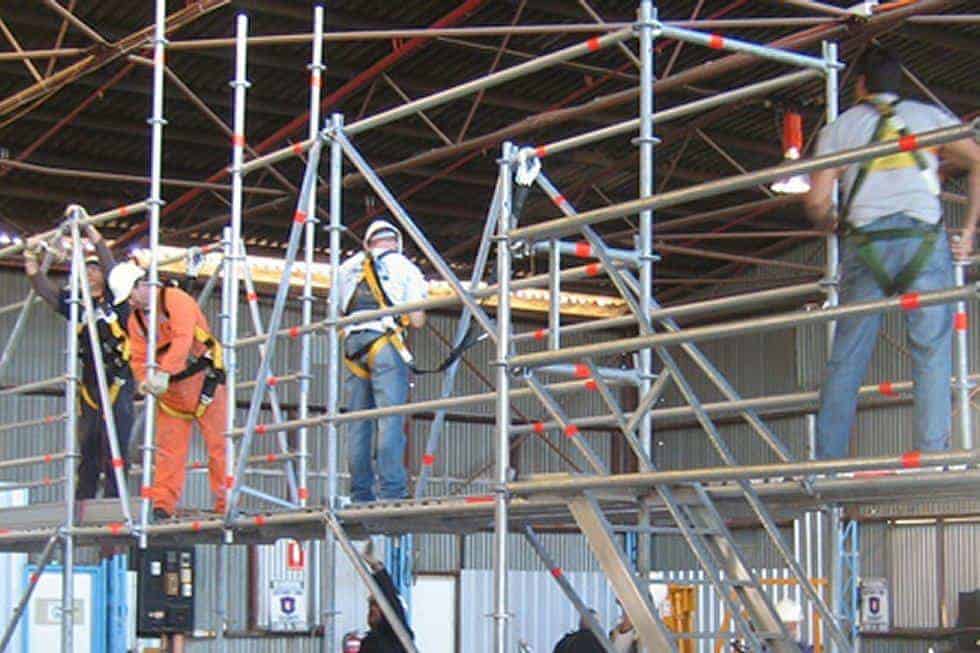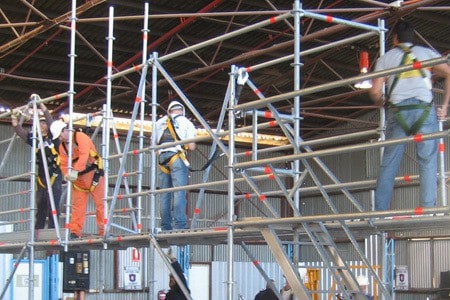“The training we have secured this week represents a major “thumbs up” to the all of the British scaffolding industry and the mostly very high standards that are delivered in the UK”.Safety & Access are also exploring the setting up of a dedicated major international partnership to deliver scaffolding skills and supervisory based training across the UAE and surrounding areas. For more information please see www.safetyaccess.co.uk
Safety & Access secures training contracts across the globe
Simian Risk offer free scaffolding safety seminars
 Work at height safety specialist Simian Risk is hosting two free Scaffolding Safety seminars at its Warrington headquarters.
The morning and afternoon courses on Friday, October 26, will focus on a variety of topics, including Management of Temporary Works and Scaffolding Rescue, with practical demonstrations in the firm’s 15,000sq ft training centre.
There will also be an NASC update, including advice on the forthcoming TG20:13 Scaffolding Guidance.
Simian Risk director Simon Hughes – widely recognised as one of the UK’s leading industry experts – said: “This is an excellent opportunity for people in the industry to get a free update on NASC Guidance, as well as advice and support on a range of issues.
Work at height safety specialist Simian Risk is hosting two free Scaffolding Safety seminars at its Warrington headquarters.
The morning and afternoon courses on Friday, October 26, will focus on a variety of topics, including Management of Temporary Works and Scaffolding Rescue, with practical demonstrations in the firm’s 15,000sq ft training centre.
There will also be an NASC update, including advice on the forthcoming TG20:13 Scaffolding Guidance.
Simian Risk director Simon Hughes – widely recognised as one of the UK’s leading industry experts – said: “This is an excellent opportunity for people in the industry to get a free update on NASC Guidance, as well as advice and support on a range of issues.
“The seminars are particularly targeted at scaffolding company owners, senior and middle managers at scaffolding contractors, HSE inspectors and any Health and Safety professionals working on construction and industry sites. “As well as presentations there will also be practical demonstrations which will give delegates a real-time perspective of how to deal with rescue situations. The TG20 Scaffolding Guidance manual is also undergoing a major rewrite in time for 2013, so we will be addressing some key issues which could be presented in the document.”The seminars run from 9.30am to 12pm and 12.30pm to 3pm. Tea and coffee will be served on arrival, with a free Hog Roast lunch. Simian Risk is one of the UK’s leading work at height safety and training specialists, working across the UK, Middle East and Far East with a range of blue chip access, construction, oil and gas and petrochemical companies. The seminars will be held at Simian Risk’s HQ at Wallis House, Birchwood Park, Warrington. For more information or to reserve a place call 0845 602 2418 or email [email protected]
Hero scaffolder tackles mugger at cashpoint

Rising river water wipes out scaffolding on bridge
 News sources have reported that scaffolding on the bridge in the centre of Milnsbridge, Huddersfield, West Yorkshire has partially collapsed as a result of rising river levels last night.
The bridge over the River Colne has been undergoing strengthening works and a partial road closure has caused traffic chaos.
The scaffold platform under the bridge has been made unsafe, though Kirklees Council says the damage is unlikely to cause delays to completion of the works.
Story Via: www.examiner.co.uk
News sources have reported that scaffolding on the bridge in the centre of Milnsbridge, Huddersfield, West Yorkshire has partially collapsed as a result of rising river levels last night.
The bridge over the River Colne has been undergoing strengthening works and a partial road closure has caused traffic chaos.
The scaffold platform under the bridge has been made unsafe, though Kirklees Council says the damage is unlikely to cause delays to completion of the works.
Story Via: www.examiner.co.uk
Let us know your thoughts in the comments below
Amazing scaffolding light show [Video]
We came across these cool videos by 1024 Architecture showing scaffolding in a different light… let us know what you think.
Scaffolding in a different light
Video#1: 60m long by 12m high, made out of scaffolding structure and semi-transparent screens, this video mapping was built on the Pont St Louis in Paris, close by Notre Dame church. It was running through their custom made video mapping software, which allowed them to draw the architectural lines live on location, directly on the structure. Video#2: For the Nuit Blanche 2010 festival, 1024 Architecture designed a 20 ton scaffolding structure built on top of the Saint Louis Bridge, downtown Paris. The show consisted of a 12 minutes looping audio reactive visual set. More info on 1024architecture.net and 1024d.wordpress.comScaffolders keep safe and “clip on”
Safety Moment – Working at Height from Stork Technical Services on Vimeo.
The message that you are about to hear is relevant to all offshore employees. The message about the importance of ‘clipping on’ when working at height comes across very strongly and we ask all of you to take some time out to watch this film. Please take this message, and the learnings that you are about to hear from Tim, and apply them every day, consistently. Make sure that the unthinkable doesn’t happen to you.
Via: www.storktechnicalservices.com
Let us know your thoughts about this video in the comments below.
Combisafe strikes the right note in Vienna with safety net fan
 With the new Raiffeisen Tower in Vienna designed to set a new world leading benchmark in terms of sustainability, it is only fitting that during the construction of the 21 storey building the main contractor would turn to the leading safety at height specialist brand, COMBISAFE. The versatile COMBISAFE Safety Net Fan not only formed an effective fall-arrest system for the workforce, but also protected pedestrians and cars at ground level from falling objects and debris.
Designed by architects Dieter Hayde and Ernst Maurier and built on the former site of the OPEC Headquarters along the Danube Canal, the 78 metre high Raiffeisen Tower has been designed to be energy efficient through measures including geothermal heating and photovoltaics. For a building with such a high benchmark for sustainability, it was vital that safety standards reached a similar level.
‘The Safety Net Fan was used to prevent material falling to the street and to protect pedestrians and cars parked next to the construction site,’ commented Mario Sontacchi. ‘The safety solution is also in place to protect the facade elements of the buildings, which are already installed under the fans.’
The 30 COMBISAFE Safety Net Fans were installed using Multi Clamps and 90 degree Elbows securing the Safety Net Fans to the concrete parapets. Due to the issues of the confined site, only a few Safety Net Fans at a time could be mounted on the ground and lifted in to place by crane.
Following considerable research and development, the Safety Net Fan is not only more cost effective, adaptable and user friendly but it is significantly stronger than conventional methods with an energy absorption of up to 4.4 Kj.
Available in two standard lengths 4.2m and 6m – it can be installed using the COMBISAFE Loose Slab Attachment which means brickwork can be built over the attachment allowing for greater flexibility of the fan position. In the event the fan is exposed to high wind forces, particularly on high rise construction, a Wind Lock is an additional option which provides greater stabilisation and ease of engagement when the fan has to be folded away.
With a projection of 3.3 metres from the building, the COMBISAFE Safety Net Fan is tested to comply with EN 1263 the European standard for safety netting and can arrest falls of up to 100kg from a height of up to 6 metres. The mesh density of the fall arrest net is 60 x 60mm and it’s delivered laced together with an extra fine 20 x 20mm debris net. The combined net is able to catch considerably smaller particles of debris, protecting workers and pedestrians at ground level making it ideal for built up areas.
Set for completion towards the end of 2012, the Raiffeisen Tower will form an impressive site on the Danube Canal and thanks to the COMBISAFE range of products, both the workforce and pedestrians will have been protected from falling objects and debris during its construction.
Website: www.combisafe.com
Contact: [email protected]
With the new Raiffeisen Tower in Vienna designed to set a new world leading benchmark in terms of sustainability, it is only fitting that during the construction of the 21 storey building the main contractor would turn to the leading safety at height specialist brand, COMBISAFE. The versatile COMBISAFE Safety Net Fan not only formed an effective fall-arrest system for the workforce, but also protected pedestrians and cars at ground level from falling objects and debris.
Designed by architects Dieter Hayde and Ernst Maurier and built on the former site of the OPEC Headquarters along the Danube Canal, the 78 metre high Raiffeisen Tower has been designed to be energy efficient through measures including geothermal heating and photovoltaics. For a building with such a high benchmark for sustainability, it was vital that safety standards reached a similar level.
‘The Safety Net Fan was used to prevent material falling to the street and to protect pedestrians and cars parked next to the construction site,’ commented Mario Sontacchi. ‘The safety solution is also in place to protect the facade elements of the buildings, which are already installed under the fans.’
The 30 COMBISAFE Safety Net Fans were installed using Multi Clamps and 90 degree Elbows securing the Safety Net Fans to the concrete parapets. Due to the issues of the confined site, only a few Safety Net Fans at a time could be mounted on the ground and lifted in to place by crane.
Following considerable research and development, the Safety Net Fan is not only more cost effective, adaptable and user friendly but it is significantly stronger than conventional methods with an energy absorption of up to 4.4 Kj.
Available in two standard lengths 4.2m and 6m – it can be installed using the COMBISAFE Loose Slab Attachment which means brickwork can be built over the attachment allowing for greater flexibility of the fan position. In the event the fan is exposed to high wind forces, particularly on high rise construction, a Wind Lock is an additional option which provides greater stabilisation and ease of engagement when the fan has to be folded away.
With a projection of 3.3 metres from the building, the COMBISAFE Safety Net Fan is tested to comply with EN 1263 the European standard for safety netting and can arrest falls of up to 100kg from a height of up to 6 metres. The mesh density of the fall arrest net is 60 x 60mm and it’s delivered laced together with an extra fine 20 x 20mm debris net. The combined net is able to catch considerably smaller particles of debris, protecting workers and pedestrians at ground level making it ideal for built up areas.
Set for completion towards the end of 2012, the Raiffeisen Tower will form an impressive site on the Danube Canal and thanks to the COMBISAFE range of products, both the workforce and pedestrians will have been protected from falling objects and debris during its construction.
Website: www.combisafe.com
Contact: [email protected] BIS Salamis to support North Sea maintenance project

Scaffolders horseplay at work funniest moments

Scaffolders Horseplay
We all know as scaffolders we can not go all day without a bit of horse play just to pass the time. We asked our FB community a while back what was the funniest things they had done to or asked a scaffolder’s labourer or trainee to do. Here are some of the best that made us laugh:- Justin Colburn posted: I told our man to jump start the disc cutter by pushing the disc on the floor and running with it. It took him five minutes before he sussed it he was knackerd!!!
- Jamie Roberts posted: Not a trick but I asked a labourer to fetch 20 five foot tubes after which he told me to f-off!! I said what? He said “now I know your taking the piss, I know they don’t do 25 ft tubes”! Then he walked off pleased as punch!
- Trevor Provencher posted: I knew a J- man who sent his apprentice for a sky-hook. He came back with a crane from another site. The J-man got fired because the company had to cover the cost of the crane. I learned from that story, instead I like to wire un-attended tools to the scaffold.
- Robert Jones posted: I told a labourer that number 44 down the road is making bacon sandwiches I told him to knock on door for to let em know what sauce he wanted on it..
- Martin Tarpey posted: My labourer was going to the shop during his break and asked if I wanted anything. I said “Yeah, get me 20 Bensons”. He then asked “What if they don’t have em?” I replied ” Get me anything” . He came back and handed me a sausage roll! It was safe to say that he had my pants down on that occasion…
- Justin Colburn posted: Sent one lad who was proper green to the bricklayers to ask for a bucket of putlock holes. He went round the hole site asking everyone even the agent funny funny day!!……
DSJ Scaffolding fined after aircraft painter fell from scaffold





![Amazing scaffolding light show [Video] Amazing scaffolding light show [Video]](https://scaffmag.com/wp-content/uploads/2012/09/scaffoldinglightshow-featured.png)




